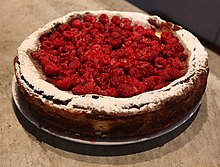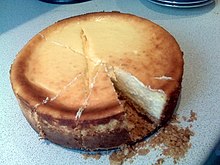Beef Wellington and Using a Hot Water Crust
 Broiled cheesecake topped with raspberries | |
| Type | Various |
|---|---|
| Course | Dessert |
| Place of origin | Aboriginal Greece |
| Chief ingredients | Cream cheese, sugar, pie crust (graham cracker crust, pastry, or sponge cake) |
| |
Cheesecake is a sweet dessert consisting of one or more layers. The main, and thickest, layer consists of a mixture of a soft, fresh cheese (typically cottage cheese, cream cheese or ricotta), eggs, and sugar. If there is a bottom layer, it near ofttimes consists of a crust or base of operations fabricated from crushed cookies (or digestive biscuits), graham crackers, pastry, or sometimes sponge cake.[1] Cheesecake may be broiled or unbaked (and is usually refrigerated).
Cheesecake is usually sweetened with saccharide and may be flavored in different ways. Vanilla, spices, lemon, chocolate, pumpkin, or other flavors may be added to the main cheese layer. Boosted flavors and visual entreatment may be added past topping the finished dessert with fruit, whipped cream, basics, cookies, fruit sauce, chocolate syrup, or other ingredients.
Culinary classification
Making a crustless cheesecake (video)
Modern cheesecake is not normally classified as an bodily "cake", despite the proper name (compare with Boston cream "pie"). Some people allocate it as a torte due to the usage of many eggs, which are the sole source of leavening, as a fundamental factor. Others notice compelling evidence that it is a custard pie, based on the overall construction, with the separate crust, the soft filling, and the absenteeism of flour.[2] Other sources identify it as a flan, or tart.[3]
History
An ancient form of cheesecake may have been a popular dish in ancient Greece even prior to Romans' adoption of it with the conquest of Greece.[4] The earliest attested mention of a cheesecake is past the Greek physician Aegimus (5th century BCE), who wrote a book on the art of making cheesecakes ( πλακουντοποιικόν σύγγραμμα — plakountopoiikon sungramma ).[5] The primeval extant cheesecake recipes are constitute in Cato the Elder's De Agri Cultura , which includes recipes for three cakes for religious uses: libum , savillum and placenta .[half-dozen] [7] [8] Of the three, placenta cake is the most like modern cheesecakes: having a crust that is separately prepared and broiled.[ix]
A more than modern version called a sambocade, fabricated with elderflower and rose water, is found in Forme of Cury, an English cookbook from 1390.[ten] [11] On this basis, chef Heston Blumenthal has argued that cheesecake is an English invention.[12]
The modern cheesecake
The English language name cheesecake has been used just since the 15th century,[13] and the cheesecake did not evolve into its modern form until somewhere around the 18th century. Europeans began removing yeast and calculation beaten eggs to the cheesecake instead. With the overpowering yeast flavor gone, the result tasted more than similar a dessert treat.[14] The early 19th-century cheesecake recipes in A New System of Domestic Cookery by Maria Rundell are fabricated with cheese curd and fresh butter. One version is thickened with fair-skinned almonds, eggs and cream, and the cakes may have included currants, brandy, raisin vino, nutmeg and orange bloom water.
Modern commercial American cream cheese was developed in 1872, when William Lawrence, from Chester, New York, while looking for a mode to recreate the soft, French cheese Neufchâtel, accidentally came upwards with a fashion of making an "unripened cheese" that is heavier and creamier; other dairymen came up with similar creations independently.[15]
Modern cheesecake comes in two different types. Along with the broiled cheesecake, some cheesecakes are made with uncooked cream cheese on a crumbled-cookie or graham cracker base. This type of cheesecake was invented in the Us.[10]
National varieties
Cheesecakes can be broadly categorized into 2 basic types: broiled and unbaked. Some do non have a crust or base. Cheesecake comes in a diversity of styles based on region:
Africa

S African rose cheesecake
South Africa
One popular variant of cheesecake in S Africa is made with whipped cream, cream cheese, gelatin for the filling, and a buttered digestive biscuit chaff. It is not baked, and is sometimes made with Amarula liqueur. This variant is very similar to British cheesecake. This cheesecake is more common in British Due south African communities.[xvi]
Asia
Japan
Japanese cheesecake, or soufflé manner or cotton cheesecake, is made with cream cheese, butter, saccharide, and eggs, and has a characteristically wobbly, airy texture, similar to chiffon cake.[17] No-broil cheesecakes are known equally rare cheesecake (Japanese: レアチーズケーキ).[18]
Philippines
The near prominent version of cheesecake in the Philippines is ube cheesecake. It is made with a base of crushed graham crackers and an upper layer of cream cheese and ube halaya (mashed regal yam with milk, sugar, and butter). Information technology can be prepared broiled or simply refrigerated. Like other ube desserts in the Philippines, it is characteristically purple in color.[19] [20] [21]
Europe
Russia
Russian-fashion cheesecake (Vatrushka) is in the form of a dough ring and filled with quark or cottage cheese.[22]

North America
United States
The The states has several unlike recipes for cheesecake and this usually depends on the region in which the cake is baked, likewise as the cultural background of the person blistering it.[23]
Chicago
Chicago-manner cheesecake is a broiled cream-cheese version that is firm on the outside with a soft and creamy texture on the inside. These cheesecakes are often made in a greased cake pan and are relatively fluffy in texture. The chaff used with this manner of cheesecake is most commonly made from shortbread that is crushed and mixed with sugar and butter. Some frozen cheesecakes are Chicago-mode.[24]
New York

New York–style cheesecake
New York–style cheesecake uses a cream cheese base, also incorporating heavy foam or sour foam.[25] The typical New York cheesecake is rich and has a dense, shine, and creamy consistency.[26]
Galleries
Cheesecakes from effectually the world
-

Bavarian baked cheesecake
-

Dutch cheesecake (kwarktaart)
-

French cheesecake (tarte au fromage)
-
German cheesecake (Käsekuchen)
-

Romanaian cheesecake
-

New York–style cheesecake with strawberries
-

Japanese no-bake cheesecake with strawberry sauce
Fruit cheesecakes
-

Blueberry and mixed-fruit cheesecake
-

New York–mode cheesecake with berries
-

No-broil cheesecake with orangish jelly
-

Cheesecake with mango
-

Lemon cheesecake
-

Raw-food strawberry cheesecake
See as well
- List of desserts
- Listing of pies, tarts and flans
- Listing of Kuih, Southeast Asian sweets
References
- ^ Ferguson Plarre Bakehouses. "A History of Cheesecakes". www.fergusonplarre.com.au. Archived from the original on 2013-11-24. Retrieved 2008-10-12 .
- ^ Berenbaum, Rose Levy (1988). The Block Bible. William Morrow Cookbooks. ISBN 978-0-688-04402-ii. p. 80.
- ^ Bender, David A. (2014-01-23). A Dictionary of Food and Nutrition. Oxford Academy Printing. ISBN9780192518422.
cheesecake: A flan or tart filled with curd or foam cheese.
- ^ Dana Bovbjerg, Jeremy Iggers, The Joy of Cheesecake, Barron'south Educational Series, 1989
- ^ Callimachus, ap. Athen, fourteen. p. 643, eastward
- ^ Cato the Elderberry, De Agri Cultura, paragraphs 75 and 76. Available in English language on-line at: University of Chicago: Penelope (Note: The "leaves" mentioned in Cato's recipe are bay leaves.)
- ^ "Cato'southward 'De Agricultura': Recipes". www.novaroma.org. Retrieved 2008-10-12 .
- ^ "Cato's 'De Agricultura': Recipes".
- ^ "A Bit of Food History: Cheesecake" (PDF). www.culinaryschools.com. Retrieved 2008-ten-12 .
- ^ a b Wilson, C. (2002). "Cheesecakes, Junkets, and Syllabubs". Gastronomica. 2 (iv): xix. doi:10.1525/gfc.2002.two.iv.19.
- ^ Pegge, Samuel (2014-12-11). The Forme of Cury, a Roll of Ancient English language Cookery. Cambridge University Press. ISBN978-i-108-07620-3.
- ^ Heston Blumenthal (2013). Historic Heston. Bloomsbury. p. 35. ISBN978-one-4088-0441-iv.
- ^ John., Ayto (2002). An A-Z of food and drink . Ayto, John. Oxford: Oxford Academy Press. ISBN0192803522. OCLC 48932542.
- ^ "The Rich History of a Favorite Dessert". Cheesecake.com. Retrieved 2019-01-09 .
- ^ cheesecake History
- ^ "A South African Favourite: Amarula Cheesecake". The International Hotel School. The International Hotel School. August 2014. Archived from the original on 2015-02-12. Retrieved 2015-01-01 .
- ^ Williamson, Olivia (three September 2015). "iii ingredient cotton cheesecake: why all the hype?" – via world wide web.telegraph.co.britain.
- ^ Yoshizuka, Setsuko (2021-05-19). "Try This Japanese-Style Rare "No-Bake" Cheesecake With Yogurt". The Bandbox Eats. Archived from the original on 2018-08-08. Retrieved 2021-01-30 .
- ^ "Ube Cheesecake". The Peach Kitchen. 5 February 2015. Retrieved vii July 2019.
- ^ "Creamy and Luscious Ube Cheesecake". Woman Scribbles . Retrieved 7 July 2019.
- ^ "Ube Cheesecake with Kokosnoot Cookie Crust and Kokosnoot Whipped Cream (Video)". The Unlikely Baker . Retrieved vii July 2019.
- ^ "Russian Oven: Male monarch's Vatrushka, a Russian-manner cheesecake - Russia Across". Rbth.com. 2015-11-26. Retrieved 2019-01-09 .
- ^ Mitchell, Russ (21 November 2010). "Say Cheesecake!". CBS News . Retrieved 17 Dec 2010.
- ^ Krause, Andrew (2006). "Different Types of Cheesecake". FoodEditorials Snacks Guide.
- ^ Nosowitz, Dan (2016-02-eighteen). "Towards A Unified Theory of the New York Cheesecake". Atlas Obscura. Archived from the original on 2016-02-21.
- ^ NY Cheese Cake Recipe & Video – Joyofbaking.com *Video Recipe*
Source: https://en.wikipedia.org/wiki/Cheesecake

0 Response to "Beef Wellington and Using a Hot Water Crust"
Enviar um comentário